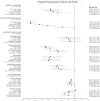Do positive psychosocial factors contribute to the prediction of coronary artery disease? A UK Biobank-based machine learning approach
- PMID: 39056264
- PMCID: PMC12011491
- DOI: 10.1093/eurjpc/zwae237
Do positive psychosocial factors contribute to the prediction of coronary artery disease? A UK Biobank-based machine learning approach
Abstract
Aims: Most prediction models for coronary artery disease (CAD) compile biomedical and behavioural risk factors using linear multivariate models. This study explores the potential of integrating positive psychosocial factors (PPFs), including happiness, satisfaction with life, and social support, into conventional and machine learning-based CAD-prediction models.
Methods and results: We included UK Biobank (UKB) participants without CAD at baseline. First, we estimated associations of individual PPFs with subsequent acute myocardial infarction (AMI) and chronic ischaemic heart disease (CIHD) using logistic regression. Then, we compared the performances of logistic regression and eXtreme Gradient Boosting (XGBoost) prediction models when adding PPFs as predictors to the Framingham Risk Score (FRS). Based on a sample size between 160 226 and 441 419 of UKB participants, happiness, satisfaction with health and life, and participation in social activities were linked to lower AMI and CIHD risk (all P-for-trend ≤ 0.04), while social support was not. In a validation sample, adding PPFs to the FRS using logistic regression and XGBoost prediction models improved neither AMI [area under the receiver operating characteristic curve (AUC) change: 0.02 and 0.90%, respectively] nor CIHD (AUC change: -1.10 and -0.88%, respectively) prediction.
Conclusion: Positive psychosocial factors were individually linked to CAD risk, in line with previous studies, and as reflected by the new European Society of Cardiology guidelines on cardiovascular disease prevention. However, including available PPFs in CAD-prediction models did not improve prediction compared with the FRS alone. Future studies should explore whether PPFs may act as CAD-risk modifiers, especially if the individual's risk is close to a decision threshold.
Keywords: Artificial intelligence; Cardiovascular disease; Disease prediction; Positive psychosocial factors; Preventive cardiology.
Plain language summary
Positive psychosocial factors (PPFs) like happiness, satisfaction with health and life, social support, and social activities can aid in successfully managing life’s challenges, stress, and disease. Consequently, they may help lower the risk and progression of cardiovascular disease. The study confirmed that PPFs were associated with lower risks of myocardial infarction and chronic ischaemic heart disease. These findings underscore the role of PPFs as risk modifiers for coronary artery disease (CAD), as recommended by the 2021 ESC Guidelines on cardiovascular disease prevention. This means that the individual risk of getting a CAD can be shifted to the next lower risk category by higher levels of happiness, satisfaction with health and life, and social support.
© The Author(s) 2024. Published by Oxford University Press on behalf of the European Society of Cardiology.
Conflict of interest statement
Conflict of interest: R.S. and G.M. received funding from the Stanley Thomas Johnson Stiftung & Gottfried und Julia Bangerter-Rhyner-Stiftung under project nos. PC 28/17 and PC 05/18, from Gesundheitsförderung Schweiz under project no. 18.191/K50001, in the context of a Horizon Europe project from the Swiss State Secretariat for Education, Research and Innovation (SERI) under contract number 22.00094, and from Wings Health Inc. in the context of a proof-of-concept study. G.M. received funding from the Research Foundation of the International Psychoanalytic University (IPU) Berlin and from the Swiss National Science Foundation under project no. 100014_135328. G.M. is co-founder, member of the board, and holds stock in Therayou AG, which is active in the field of digital and blended mental healthcare. All other authors have no conflict of interest.
Figures



Comment in
-
Positive psychology goes cardiology: what we have learned and what's next.Eur J Prev Cardiol. 2025 Apr 22;32(6):453-455. doi: 10.1093/eurjpc/zwae228. Eur J Prev Cardiol. 2025. PMID: 38978498 No abstract available.
References
-
- Brown JC, Gerhardt TE, Kwon E. Risk factors for coronary artery disease. In: StatPearls [Internet]. Treasure Island, FL: StatPearls Publishing; 2022. https://www.ncbi.nlm.nih.gov/books/NBK554410/. - PubMed
-
- Krittanawong C, Zhang H, Wang Z, Aydar M, Kitai T. Artificial intelligence in precision cardiovascular medicine. J Am Coll Cardiol 2017;69:2657–2664. - PubMed
MeSH terms
Grants and funding
LinkOut - more resources
Full Text Sources
Medical
Miscellaneous

